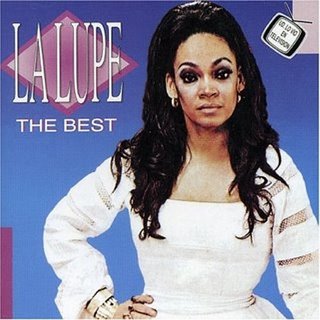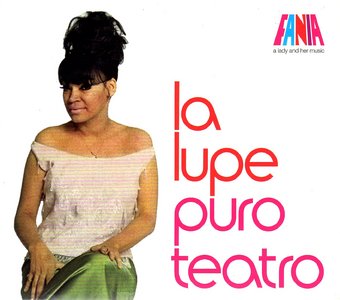Cuba’s La Lupe: “A Musical Animal”
Dariela Aquique

HAVANA TIMES — A number of programs on Cuban radio and television aim to introduce the new generations, and remind the old ones, of the most notable figures of Cuban music of all time.
There are programs devoted to such renowned musicians as Bola de Nieve, Benny More, Elena Burque, Vicente Valdez and others of their stature. The work of other musicians, however, is divulged with a bit more reticence, or not at all. The main reason for this is that these artists chose to live outside Cuba. This is the case of Perez Prado, Celia Cruz, Olga Guillot and Blanca Rosa Gil, to name only a few.
This is an attitude that has made entire generations forget, or remain oblivious to, the work of great luminaries of Cuban music. I want to devote this post to one of those stars, a singer who, though still revered in many parts of the world, has practically been erased from the memory of Cubans.
Guadalupe Victoria Yoli Raymond would be a long, unfamiliar name to most. If we were to say “La Lupe”, however, many would know we were speaking of the character in La isla de los amores infinitos (“The Island of Infinite Loves”), published by Cuban author Daina Chaviano in 2006, an award-winning work that has been translated into 20 languages.
They would also recall a film called La Mala (“Bad Girl”), starring Cuban actors Lena Burke and Jorge Perugorria, or the book Con el Diablo en el cuerpo (“The Devil in the Body”), by Dominican author Rafael Dario Duran, or perhaps “La Lupe Way”, the name with which East 140th Street in the Bronx, New York, was christened.
Perhaps the name would bring to mind the score of the film Mujeres al borde de un ataque de nervios (“Women at the Brink of a Nervous Breakdown”) or La ley del deseo (“The Law of Desire”), by controversial Spanish director Pedro Almodovar, or shows staged by transvestites or transformists who try and imitate the peculiar style of the woman who sang Puro teatro (“Pure Melodrama”), Fever or Si vuelves tu (“If You Return”).
This amazing artist is practically unknown in Cuba, and invoked only in two theatre pieces starring actresses Montse Duany or Maria Teresa Pina, directed by Barbra Rivero or Veronica Lynn, respectively, that is, only in pieces staged by Cuba’s gay community as tribute to her.
Her song Que te pedi (“What Did I ask of You?”), is also played at the beginning of the 2001 Cuban film Nada (“Nothing”), directed by Juan Carlos Cremata.
 It is regrettable that a performer of such virtuosity should have been forgotten by so many people in the country where she was born, lived and began her career as a singer. La Lupe came into this world in December of 1936 in San Pedrito, Santiago de Cuba, the daughter of a worker at the Bacardi rum factory.
It is regrettable that a performer of such virtuosity should have been forgotten by so many people in the country where she was born, lived and began her career as a singer. La Lupe came into this world in December of 1936 in San Pedrito, Santiago de Cuba, the daughter of a worker at the Bacardi rum factory.
At the end of the 1950s, she moved to Havana, putting her career as a teacher behind her. She made her debut in the world of music singing at different locales around the city. In 1959, with her first husband Eulogio “Yoyo” Reyes, she formed the Trio Tropicuba, a band that performed at a legendary nightclub in Havana, La Red.
Her singing style, full of extravagant passion, quickly earned her much renown in Havana. They say she was all over the place on stage, that she was so short that, during one of her emotional fits, she would step down and sing next to the stools at the bar, that she would take off her shoes and hit the pianist with them.
She left Cuba in the 60s (her style of performance was not well perceived by the new government). She traveled to Mexico and then to New York, where she started to sing at a Midtown bar, La Barraca, charging 30 dollars for performance.
In a very short span of time, her talent catapulted her to stardom. She became the first Latino singer to perform in Carnegie Hall and Madison Square Garden, as many publications of the time such as the Village Voice, reported back then.
In the 1970s, her reckless lifestyle and habit of overspending, plus the emergence of salsa music as a force to be reckoned with, spelled the quick decline of her popularity as a musician and he she fell from stardom.
Practically poor, having been forced to mortgage her mansion, she moved to Puerto Rico. Her work there caused her some problems with a number of television broadcasters. Her distinctive style crossed a limit: during a performance aired on Puerto Rico’s WAPA channel, she tore of all of her clothes. This spelled the end for La Lupe, who was forced to return to New York.
In the 80s, she converted from the Santeria creed into evangelism. She composed and performed a number of songs that will probably be distributed one day.
Known as “the queen of Latin Soul”, La Yiyiyi, or, quite simply, La Lupe, on February 29, 1992, she died of cardiac arrest in a small apartment in the Bronx.
It would be good if someone could do this great artist justice through a documentary about her life, about this woman called “the creator of the art of frenzy” by Hemingway, a “phenomenal phenomenon” by Cuban writer Guillermo Cabrera Infante, “a genius” by Pablo Picasso and a “musical animal” by Jean Paul Sartre.






I learned about La Lupe during a Latin Cinema class and subsequently did a presentation on her. I instantly fell in love with her style and passion, it was addictive. I currently live in the Bronx and occasionally visit the areas she frequented. She will always hold a place in my heart and my playlists… Great piece, honestly enjoyed it 🙂